which of the following men might have explained the the auk's loss of ability to fly with the following hypothesis? "since the auk stopped using its wings, the wings became smaller and these aquired trait was passed on to the offspring"
de Vries
Lamarck
Darwin
Mendel
To solve the question regarding which man might have explained the auk's loss of ability to fly with the hypothesis that "since the auk stopped using its wings, the wings became smaller and this acquired trait was passed on to the offspring," we can follow these steps:
1. Understand the Hypothesis: The hypothesis suggests that the auk stopped using its wings, which led to a reduction in wing size. This change is described as an acquired trait, meaning it was not genetically inherited but developed due to disuse.
2. Identify the Key Concept: The key concept here is the "inheritance of acquired traits." This idea posits that characteristics acquired during an organism's lifetime can be passed on to its offspring.
3. Recall Historical Theories: To answer the question, we need to recall which scientist proposed the theory of inheritance of acquired traits.
4. Recognize the Scientist: The scientist who is most famously associated with the theory of inheritance of acquired traits is Jean-Baptiste Lamarck. He suggested that organisms could pass on traits acquired during their lifetime to their descendants.
5. Conclusion: Based on the hypothesis provided in the question, the correct answer is that Lamarck would have explained the auk's loss of ability to fly in this manner.
Final Answer:
The correct answer is Lamarck.
---
The correct answer is Lamarck.
Topper's Solved these Questions
Similar Questions
in an ionic bond the cation tends to polarise the electron cloud of the anion by pulling electron density towards itself This causes development of covalent character in the ionic bond because the electron density gets localised in between the nuclei The tendency of the cation to bring about the polarisation of the anion is expressed as its polasising power The ability of ion to undergo polarisation is called its polarisability The polarising power of a cation or an anion is decided on the basis of F ajans' rules as follows .
(i) The smaller the cation, the higher is its polarising power
(ii) Cations with pseudo-noble gas configuration (ns2np6nd10) have relatively high polarising power than those with noble gas configuration (ns2np6)
(iii) The larger the size of the anion, the higher is its polarisability
The ionic conductance of which of the following is the highest ? .
View SolutionDark Snow
Most of Greenland’s interior is covered by a thick layer of ice and compressed snow known as the Greenland Ice Sheet. The size of the ice sheet fluctuates seasonally: in summer, average daily high temperatures in Greenland can rise to slightly above 50 degrees Fahrenheit, partially melting the ice, in the winter, the sheet thickens as additional snow falls, and average daily low temperatures can drop to (12) as low as 20 degrees–––––––––––––––––––––.
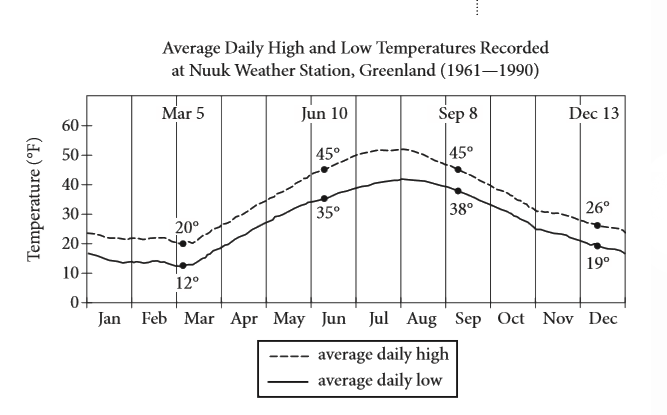
Typically, the ice sheet begins to show evidence of thawing in late (13)summer. This follows––––––––––––––––––––––– several weeks of higher temperatures. 14 For example––––––––––––––, in the summer of 2012, virtually the entire Greenland Ice Sheet underwent thawing at or near its surface by mid-July, the earliest date on record. Most scientists looking for the causes of the Great Melt of 2012 have focused exclusively on rising temperatures. The summer of 2012 was the warmest in 170 years, records show. But Jason (15) Box, an associate––––––––––––––––––– professor of geology at Ohio State believes that another factor added to the early (16) (thaw), the “dark snow” problem.
According to Box, a leading Greenland expert, tundra fires in 2012 from as far away as North America produced great amounts of soot, some (17) of it–––––drifted over Greenland in giant plumes of smoke and then (18) fell–––– as particles onto the ice sheet. Scientists have long known that soot particles facilitate melting by darkening snow and ice, limiting (19) it’s–––– ability to reflect the Sun’s rays. As Box explains, “Soot is an extremely powerful light absorber. It settles over the ice and captures the Sun’s heat.” The result is a self-reinforcing cycle. As the ice melts, the land and water under the ice become exposed, and since land and water are darker than snow, the surface absorbs even more heat, which (20) is related to the rising temperatures–––––––––––––––––––––––––––––––––––––––.
[1] Box’s research is important because the fires of 2012 may not be a one-time phenomenon. [2] According to scientists, rising Arctic temperatures are making northern latitudes greener and thus more fire prone.[3] The pattern Box observed in 2012 may repeat (21) itself again––––––––––––, with harmful effects on the Arctic ecosystem. [4] Box is currently organizing an expedition to gather this crucial information. [5] The next step for Box and his team is to travel to Greenland to perform direct sampling of the ice in order to determine just how much the soot is contributing to the melting of the ice sheet. [6] Members of the public will be able to track his team’s progress—and even help fund the expedition—through a website Box has created. (22)
View Solution
Knowledge Check
Which of the following statement are correct ?
(i) Smaller the gold number of lyophilic colloid, larger will be its protective power
(ii) Lyophilic sols , in contrast to lyophobic sols are easily coagulated on addition of small amounts of electrolytes.
(iii) Ferric chloride solution is used to stop bleeding from a fresh cut because it coagulating the blood
(iv) The flocculatin value of arsenious sulphide sol is independent of the anion of the coagulatingA(i),(ii) and (iii)B(i) , (iii) and (iv)C(ii) , (iii) and (iv)D(i),(ii) and (iv)Dark Snow
Most of Greenland’s interior is covered by a thick layer of ice and compressed snow known as the Greenland Ice Sheet. The size of the ice sheet fluctuates seasonally: in summer, average daily high temperatures in Greenland can rise to slightly above 50 degrees Fahrenheit, partially melting the ice, in the winter, the sheet thickens as additional snow falls, and average daily low temperatures can drop to (12) as low as 20 degrees–––––––––––––––––––––.
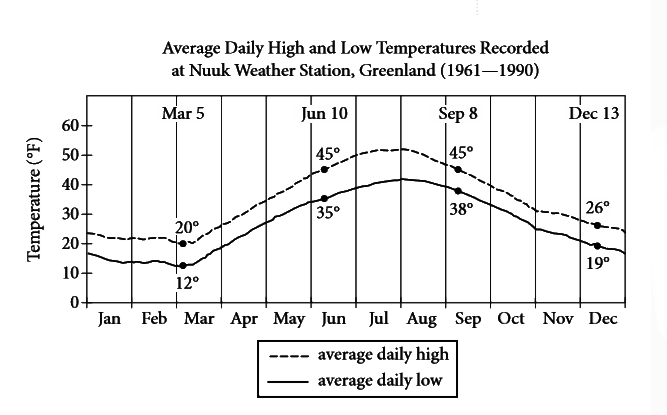
Typically, the ice sheet begins to show evidence of thawing in late (13)summer. This follows––––––––––––––––––––––– several weeks of higher temperatures. 14 For example––––––––––––––, in the summer of 2012, virtually the entire Greenland Ice Sheet underwent thawing at or near its surface by mid-July, the earliest date on record. Most scientists looking for the causes of the Great Melt of 2012 have focused exclusively on rising temperatures. The summer of 2012 was the warmest in 170 years, records show. But Jason (15) Box, an associate––––––––––––––––––– professor of geology at Ohio State believes that another factor added to the early (16) (thaw), the “dark snow” problem.
According to Box, a leading Greenland expert, tundra fires in 2012 from as far away as North America produced great amounts of soot, some (17) of it–––––drifted over Greenland in giant plumes of smoke and then (18) fell–––– as particles onto the ice sheet. Scientists have long known that soot particles facilitate melting by darkening snow and ice, limiting (19) it’s–––– ability to reflect the Sun’s rays. As Box explains, “Soot is an extremely powerful light absorber. It settles over the ice and captures the Sun’s heat.” The result is a self-reinforcing cycle. As the ice melts, the land and water under the ice become exposed, and since land and water are darker than snow, the surface absorbs even more heat, which (20) is related to the rising temperatures–––––––––––––––––––––––––––––––––––––––.
[1] Box’s research is important because the fires of 2012 may not be a one-time phenomenon. [2] According to scientists, rising Arctic temperatures are making northern latitudes greener and thus more fire prone.[3] The pattern Box observed in 2012 may repeat (21) itself again––––––––––––, with harmful effects on the Arctic ecosystem. [4] Box is currently organizing an expedition to gather this crucial information. [5] The next step for Box and his team is to travel to Greenland to perform direct sampling of the ice in order to determine just how much the soot is contributing to the melting of the ice sheet. [6] Members of the public will be able to track his team’s progress—and even help fund the expedition—through a website Box has created. (22)
13. Which choice most effectively combines the two sentences at the underlined portion?Asummer, followingBsummer, and this thawing followsCsummer, and such thawing followsDsummer and this evidence followsDark Snow
Most of Greenland’s interior is covered by a thick layer of ice and compressed snow known as the Greenland Ice Sheet. The size of the ice sheet fluctuates seasonally: in summer, average daily high temperatures in Greenland can rise to slightly above 50 degrees Fahrenheit, partially melting the ice, in the winter, the sheet thickens as additional snow falls, and average daily low temperatures can drop to (12) as low as 20 degrees–––––––––––––––––––––.

Typically, the ice sheet begins to show evidence of thawing in late (13)summer. This follows––––––––––––––––––––––– several weeks of higher temperatures. 14 For example––––––––––––––, in the summer of 2012, virtually the entire Greenland Ice Sheet underwent thawing at or near its surface by mid-July, the earliest date on record. Most scientists looking for the causes of the Great Melt of 2012 have focused exclusively on rising temperatures. The summer of 2012 was the warmest in 170 years, records show. But Jason (15) Box, an associate––––––––––––––––––– professor of geology at Ohio State believes that another factor added to the early (16) (thaw), the “dark snow” problem.
According to Box, a leading Greenland expert, tundra fires in 2012 from as far away as North America produced great amounts of soot, some (17) of it–––––drifted over Greenland in giant plumes of smoke and then (18) fell–––– as particles onto the ice sheet. Scientists have long known that soot particles facilitate melting by darkening snow and ice, limiting (19) it’s–––– ability to reflect the Sun’s rays. As Box explains, “Soot is an extremely powerful light absorber. It settles over the ice and captures the Sun’s heat.” The result is a self-reinforcing cycle. As the ice melts, the land and water under the ice become exposed, and since land and water are darker than snow, the surface absorbs even more heat, which (20) is related to the rising temperatures–––––––––––––––––––––––––––––––––––––––.
[1] Box’s research is important because the fires of 2012 may not be a one-time phenomenon. [2] According to scientists, rising Arctic temperatures are making northern latitudes greener and thus more fire prone.[3] The pattern Box observed in 2012 may repeat (21) itself again––––––––––––, with harmful effects on the Arctic ecosystem. [4] Box is currently organizing an expedition to gather this crucial information. [5] The next step for Box and his team is to travel to Greenland to perform direct sampling of the ice in order to determine just how much the soot is contributing to the melting of the ice sheet. [6] Members of the public will be able to track his team’s progress—and even help fund the expedition—through a website Box has created. (22)ANO CHANGEBHowever,CAs such,DMoreover,
Dark Snow
Most of Greenland’s interior is covered by a thick layer of ice and compressed snow known as the Greenland Ice Sheet. The size of the ice sheet fluctuates seasonally: in summer, average daily high temperatures in Greenland can rise to slightly above 50 degrees Fahrenheit, partially melting the ice, in the winter, the sheet thickens as additional snow falls, and average daily low temperatures can drop to (12) as low as 20 degrees–––––––––––––––––––––.
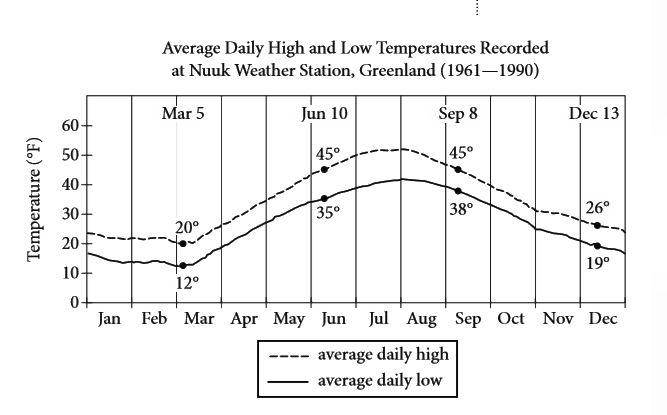
Typically, the ice sheet begins to show evidence of thawing in late (13)summer. This follows––––––––––––––––––––––– several weeks of higher temperatures. 14 For example––––––––––––––, in the summer of 2012, virtually the entire Greenland Ice Sheet underwent thawing at or near its surface by mid-July, the earliest date on record. Most scientists looking for the causes of the Great Melt of 2012 have focused exclusively on rising temperatures. The summer of 2012 was the warmest in 170 years, records show. But Jason (15) Box, an associate––––––––––––––––––– professor of geology at Ohio State believes that another factor added to the early (16) (thaw), the “dark snow” problem.
According to Box, a leading Greenland expert, tundra fires in 2012 from as far away as North America produced great amounts of soot, some (17) of it–––––drifted over Greenland in giant plumes of smoke and then (18) fell–––– as particles onto the ice sheet. Scientists have long known that soot particles facilitate melting by darkening snow and ice, limiting (19) it’s–––– ability to reflect the Sun’s rays. As Box explains, “Soot is an extremely powerful light absorber. It settles over the ice and captures the Sun’s heat.” The result is a self-reinforcing cycle. As the ice melts, the land and water under the ice become exposed, and since land and water are darker than snow, the surface absorbs even more heat, which (20) is related to the rising temperatures–––––––––––––––––––––––––––––––––––––––.
[1] Box’s research is important because the fires of 2012 may not be a one-time phenomenon. [2] According to scientists, rising Arctic temperatures are making northern latitudes greener and thus more fire prone.[3] The pattern Box observed in 2012 may repeat (21) itself again––––––––––––, with harmful effects on the Arctic ecosystem. [4] Box is currently organizing an expedition to gather this crucial information. [5] The next step for Box and his team is to travel to Greenland to perform direct sampling of the ice in order to determine just how much the soot is contributing to the melting of the ice sheet. [6] Members of the public will be able to track his team’s progress—and even help fund the expedition—through a website Box has created. (22)
12. Which choice most accurately and effectively represents the information in the graph?
View SolutionDark Snow
Most of Greenland’s interior is covered by a thick layer of ice and compressed snow known as the Greenland Ice Sheet. The size of the ice sheet fluctuates seasonally: in summer, average daily high temperatures in Greenland can rise to slightly above 50 degrees Fahrenheit, partially melting the ice, in the winter, the sheet thickens as additional snow falls, and average daily low temperatures can drop to (12) as low as 20 degrees–––––––––––––––––––––.
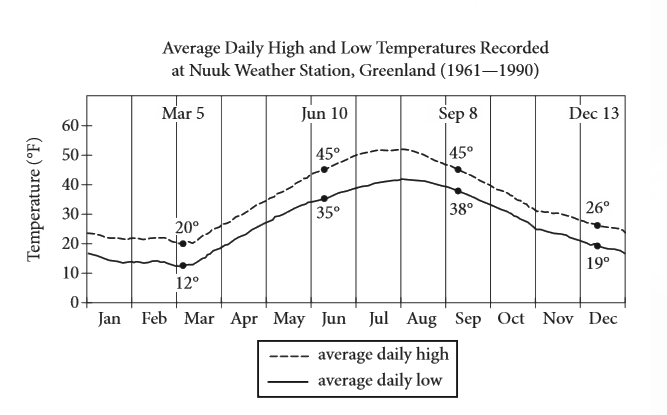
Typically, the ice sheet begins to show evidence of thawing in late (13)summer. This follows––––––––––––––––––––––– several weeks of higher temperatures. 14 For example––––––––––––––, in the summer of 2012, virtually the entire Greenland Ice Sheet underwent thawing at or near its surface by mid-July, the earliest date on record. Most scientists looking for the causes of the Great Melt of 2012 have focused exclusively on rising temperatures. The summer of 2012 was the warmest in 170 years, records show. But Jason (15) Box, an associate––––––––––––––––––– professor of geology at Ohio State believes that another factor added to the early (16) (thaw), the “dark snow” problem.
According to Box, a leading Greenland expert, tundra fires in 2012 from as far away as North America produced great amounts of soot, some (17) of it–––––drifted over Greenland in giant plumes of smoke and then (18) fell–––– as particles onto the ice sheet. Scientists have long known that soot particles facilitate melting by darkening snow and ice, limiting (19) it’s–––– ability to reflect the Sun’s rays. As Box explains, “Soot is an extremely powerful light absorber. It settles over the ice and captures the Sun’s heat.” The result is a self-reinforcing cycle. As the ice melts, the land and water under the ice become exposed, and since land and water are darker than snow, the surface absorbs even more heat, which (20) is related to the rising temperatures–––––––––––––––––––––––––––––––––––––––.
[1] Box’s research is important because the fires of 2012 may not be a one-time phenomenon. [2] According to scientists, rising Arctic temperatures are making northern latitudes greener and thus more fire prone.[3] The pattern Box observed in 2012 may repeat (21) itself again––––––––––––, with harmful effects on the Arctic ecosystem. [4] Box is currently organizing an expedition to gather this crucial information. [5] The next step for Box and his team is to travel to Greenland to perform direct sampling of the ice in order to determine just how much the soot is contributing to the melting of the ice sheet. [6] Members of the public will be able to track his team’s progress—and even help fund the expedition—through a website Box has created. (22)
View SolutionDark Snow
Most of Greenland’s interior is covered by a thick layer of ice and compressed snow known as the Greenland Ice Sheet. The size of the ice sheet fluctuates seasonally: in summer, average daily high temperatures in Greenland can rise to slightly above 50 degrees Fahrenheit, partially melting the ice, in the winter, the sheet thickens as additional snow falls, and average daily low temperatures can drop to (12) as low as 20 degrees–––––––––––––––––––––.
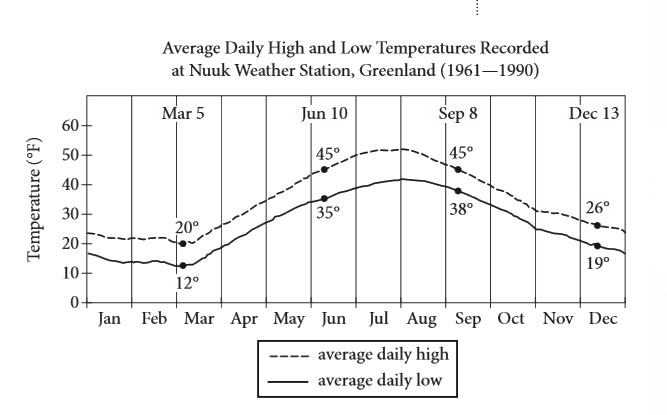
Typically, the ice sheet begins to show evidence of thawing in late (13)summer. This follows––––––––––––––––––––––– several weeks of higher temperatures. 14 For example––––––––––––––, in the summer of 2012, virtually the entire Greenland Ice Sheet underwent thawing at or near its surface by mid-July, the earliest date on record. Most scientists looking for the causes of the Great Melt of 2012 have focused exclusively on rising temperatures. The summer of 2012 was the warmest in 170 years, records show. But Jason (15) Box, an associate––––––––––––––––––– professor of geology at Ohio State believes that another factor added to the early (16) (thaw), the “dark snow” problem.
According to Box, a leading Greenland expert, tundra fires in 2012 from as far away as North America produced great amounts of soot, some (17) of it–––––drifted over Greenland in giant plumes of smoke and then (18) fell–––– as particles onto the ice sheet. Scientists have long known that soot particles facilitate melting by darkening snow and ice, limiting (19) it’s–––– ability to reflect the Sun’s rays. As Box explains, “Soot is an extremely powerful light absorber. It settles over the ice and captures the Sun’s heat.” The result is a self-reinforcing cycle. As the ice melts, the land and water under the ice become exposed, and since land and water are darker than snow, the surface absorbs even more heat, which (20) is related to the rising temperatures–––––––––––––––––––––––––––––––––––––––.
[1] Box’s research is important because the fires of 2012 may not be a one-time phenomenon. [2] According to scientists, rising Arctic temperatures are making northern latitudes greener and thus more fire prone.[3] The pattern Box observed in 2012 may repeat (21) itself again––––––––––––, with harmful effects on the Arctic ecosystem. [4] Box is currently organizing an expedition to gather this crucial information. [5] The next step for Box and his team is to travel to Greenland to perform direct sampling of the ice in order to determine just how much the soot is contributing to the melting of the ice sheet. [6] Members of the public will be able to track his team’s progress—and even help fund the expedition—through a website Box has created. (22)
View SolutionDark Snow
Most of Greenland’s interior is covered by a thick layer of ice and compressed snow known as the Greenland Ice Sheet. The size of the ice sheet fluctuates seasonally: in summer, average daily high temperatures in Greenland can rise to slightly above 50 degrees Fahrenheit, partially melting the ice, in the winter, the sheet thickens as additional snow falls, and average daily low temperatures can drop to (12) as low as 20 degrees–––––––––––––––––––––.
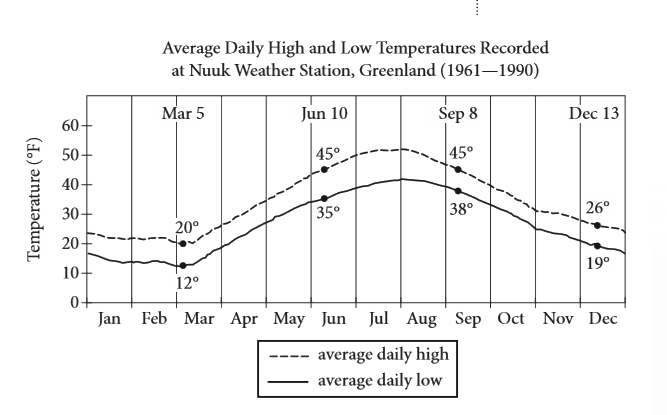
Typically, the ice sheet begins to show evidence of thawing in late (13)summer. This follows––––––––––––––––––––––– several weeks of higher temperatures. 14 For example––––––––––––––, in the summer of 2012, virtually the entire Greenland Ice Sheet underwent thawing at or near its surface by mid-July, the earliest date on record. Most scientists looking for the causes of the Great Melt of 2012 have focused exclusively on rising temperatures. The summer of 2012 was the warmest in 170 years, records show. But Jason (15) Box, an associate––––––––––––––––––– professor of geology at Ohio State believes that another factor added to the early (16) (thaw), the “dark snow” problem.
According to Box, a leading Greenland expert, tundra fires in 2012 from as far away as North America produced great amounts of soot, some (17) of it–––––drifted over Greenland in giant plumes of smoke and then (18) fell–––– as particles onto the ice sheet. Scientists have long known that soot particles facilitate melting by darkening snow and ice, limiting (19) it’s–––– ability to reflect the Sun’s rays. As Box explains, “Soot is an extremely powerful light absorber. It settles over the ice and captures the Sun’s heat.” The result is a self-reinforcing cycle. As the ice melts, the land and water under the ice become exposed, and since land and water are darker than snow, the surface absorbs even more heat, which (20) is related to the rising temperatures–––––––––––––––––––––––––––––––––––––––.
[1] Box’s research is important because the fires of 2012 may not be a one-time phenomenon. [2] According to scientists, rising Arctic temperatures are making northern latitudes greener and thus more fire prone.[3] The pattern Box observed in 2012 may repeat (21) itself again––––––––––––, with harmful effects on the Arctic ecosystem. [4] Box is currently organizing an expedition to gather this crucial information. [5] The next step for Box and his team is to travel to Greenland to perform direct sampling of the ice in order to determine just how much the soot is contributing to the melting of the ice sheet. [6] Members of the public will be able to track his team’s progress—and even help fund the expedition—through a website Box has created. (22)
View SolutionDark Snow
Most of Greenland’s interior is covered by a thick layer of ice and compressed snow known as the Greenland Ice Sheet. The size of the ice sheet fluctuates seasonally: in summer, average daily high temperatures in Greenland can rise to slightly above 50 degrees Fahrenheit, partially melting the ice, in the winter, the sheet thickens as additional snow falls, and average daily low temperatures can drop to (12) as low as 20 degrees–––––––––––––––––––––.

Typically, the ice sheet begins to show evidence of thawing in late (13)summer. This follows––––––––––––––––––––––– several weeks of higher temperatures. 14 For example––––––––––––––, in the summer of 2012, virtually the entire Greenland Ice Sheet underwent thawing at or near its surface by mid-July, the earliest date on record. Most scientists looking for the causes of the Great Melt of 2012 have focused exclusively on rising temperatures. The summer of 2012 was the warmest in 170 years, records show. But Jason (15) Box, an associate––––––––––––––––––– professor of geology at Ohio State believes that another factor added to the early (16) (thaw), the “dark snow” problem.
According to Box, a leading Greenland expert, tundra fires in 2012 from as far away as North America produced great amounts of soot, some (17) of it–––––drifted over Greenland in giant plumes of smoke and then (18) fell–––– as particles onto the ice sheet. Scientists have long known that soot particles facilitate melting by darkening snow and ice, limiting (19) it’s–––– ability to reflect the Sun’s rays. As Box explains, “Soot is an extremely powerful light absorber. It settles over the ice and captures the Sun’s heat.” The result is a self-reinforcing cycle. As the ice melts, the land and water under the ice become exposed, and since land and water are darker than snow, the surface absorbs even more heat, which (20) is related to the rising temperatures–––––––––––––––––––––––––––––––––––––––.
[1] Box’s research is important because the fires of 2012 may not be a one-time phenomenon. [2] According to scientists, rising Arctic temperatures are making northern latitudes greener and thus more fire prone.[3] The pattern Box observed in 2012 may repeat (21) itself again––––––––––––, with harmful effects on the Arctic ecosystem. [4] Box is currently organizing an expedition to gather this crucial information. [5] The next step for Box and his team is to travel to Greenland to perform direct sampling of the ice in order to determine just how much the soot is contributing to the melting of the ice sheet. [6] Members of the public will be able to track his team’s progress—and even help fund the expedition—through a website Box has created. (22)
View Solution
